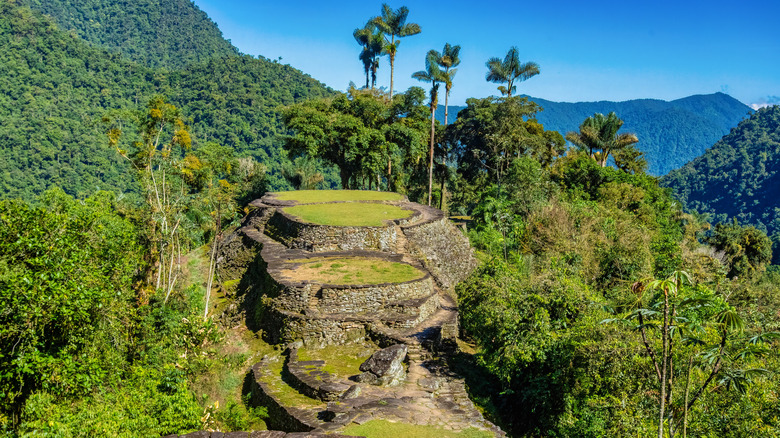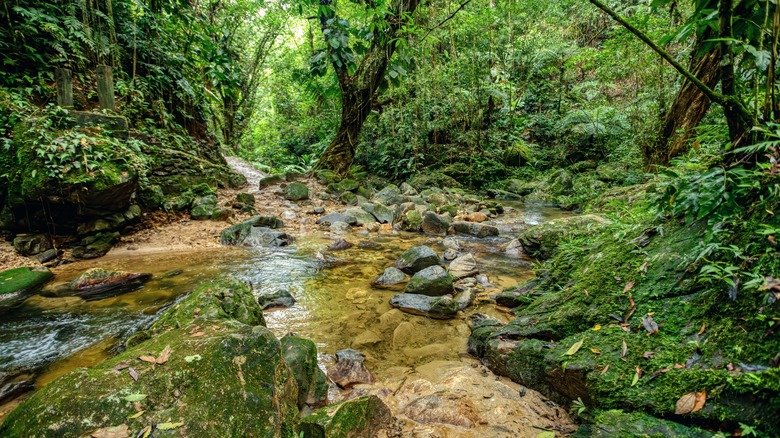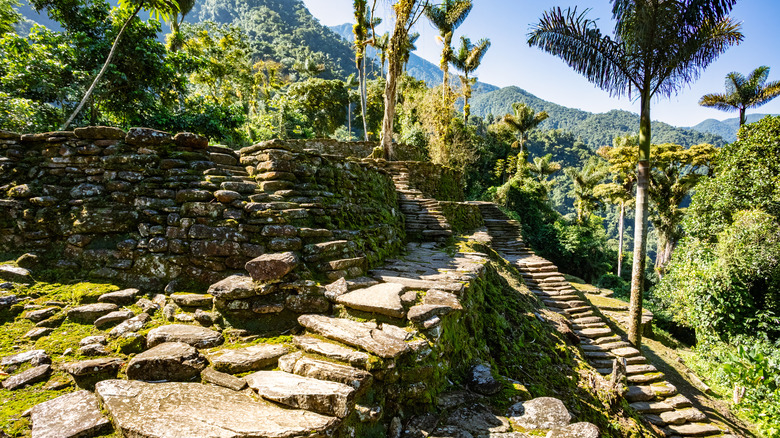This South American Country's Secret 'Lost City' Is Like A Tropical Machu Picchu
Colombia is a treasure chest of hidden wonders, from the breathtaking white city of Popayán to vibrant cities like Medellín. But among its most enchanting secrets is La Ciudad Perdida, or "the Lost City," a remote archaeological marvel perched in the tropical rainforest of the Sierra Nevada de Santa Marta mountains. While Machu Picchu, with its iconic "hike of death", draws massive crowds, this lesser-known site offers a serene and intimate exploration of ancient ruins, flanked by the gentle murmurs of the Buritaca River and the hum of the jungle.
So, why isn't this incredible slice of history overrun with tourists? The answer might have something to do with the journey itself. There are no railways or roads to Ciudad Perdida — reaching it requires a multi-day trek through the rainforest. For those who take on the hike, though the reward is unparalleled: An enchanting city of terraces, stone staircases, and an enduring connection to the bygone Tairona civilization. It's an adventure few forget and one that lingers in the imagination long after the last step is taken.
Journey to the Lost City
The Lost City, believed to have been built between 700 and 800 A.D., was once the bustling heart of the Tairona people, a sophisticated civilization that thrived long before the Spanish conquest. The Tairona people fled during colonial times, leaving the abandoned city hidden from the outside world (though it was still known to local Indigenous tribes) for centuries until its rediscovery in 1976. Today, historians estimate that the city was home to 2,000 to 8,000 inhabitants.
Reaching Ciudad Perdida means embarking on an unforgettable journey through the Sierra Nevada de Santa Marta, a mountain range crowned with the world's highest coastal peaks. This UNESCO Biosphere Reserve is a lush paradise teeming with life: Over 600 species of birds, vividly colored butterflies, and towering trees that create a lush green canopy. The air is thick with the scent of earth and blossoms, and the streams that carve through the jungle sparkle in the sunlight. As you hike, the landscape shifts between dense rainforest, some steep hills, and hidden waterfalls.
The trek itself takes three to five days each way. Tour operators often bring mules along with you on the hike to carry your belongings. Your path winds through inclines, river crossings (both by foot and hanging bridge), and muddy trails. Along the way, you'll find moments of rest, like cooling off in natural pools or sitting beside cascading waterfalls, and nights are spent in rustic camps equipped with bunk beds. The final approach to Ciudad Perdida requires climbing over 1,000 stone steps, an ascent that feels like a pilgrimage to the past.
The heart of the Lost City and the road home
When you arrive at Ciudad Perdida, you'll be met by the sight of 169 stone terraces carved into the mountainside, connected by ancient stairways and encircled by jungle. Divided into eight sectors, the archaeological site contains remnants of canals, ceremonial structures, and the foundations of homes and silos. The Tairona's ingenuity is evident in every stone, and as you walk the terraces, it's easy to imagine the thriving community that once lived here. The Lost City is managed collaboratively by the Colombian Institute of Anthropology and History and Indigenous groups, and some members of Indigenous communities still live on the Lost City grounds. Visitors may also encounter members of the Colombian Army, present to ensure safety in this remote region.
After exploring the Lost City, the return trek offers time to reflect on the experience. Many travelers begin and end their journey in Santa Marta, a coastal city full of charm and relaxation. In the city, stroll through Parque de los Novios for a celebratory meal, or unwind on Santa Marta's golden beaches, perfect for swimming or sailing. From Santa Marta, you can also reach the quieter town of Palomino to see both beaches and mountains. Returning to the modern world after such an adventure feels surreal, and with the memory of the Lost City lingering, in a sense, it's never truly lost.


